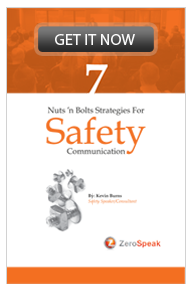Companies claim to value safety over all else but unknowingly engage in activities that undermine that desire.
 Good companies want to protect their people from harm in the workplace. Of that there is little doubt. A problem exists, however, when deed does not align with word. Over 70% of North American workers are not fully engaged in their job. Without being fully engaged in the job, there is little likelihood that an employee will be fully engaged in safely doing the job.
Good companies want to protect their people from harm in the workplace. Of that there is little doubt. A problem exists, however, when deed does not align with word. Over 70% of North American workers are not fully engaged in their job. Without being fully engaged in the job, there is little likelihood that an employee will be fully engaged in safely doing the job.
Companies claim to value safety over all else. But they unknowingly engage in activities that undermine that desire. Companies want to become world-class performers in safety but measure themselves against industry averages. Companies say they make safety the top priority but then don't invest in peripheral training. Many don't have support materials to own the hearts and minds of their employees. Eventually employees clue-in and say, "don't tell me how much you care - show me."
The safety world is moving away from simple compliance models. Integration of omnipresent safety (permeating throughout the organization) is the next level. Here's where the real work needs to be done. Let's start with the 3 things that organizations must do better before safety performance can improve.
1Zero is not a target. If you are laying in bed reading this before your feet hit the floor for the day, congratulations. You are already at Zero. Zero is how you start each day. Zero is likely how you will end the day too. The truth is, most people don’t get hurt at work. A small percentage do. And while it is important to concentrate on fixing the decisions of a few, let’s not forget that most employees don’t get hurt. Zero is your natural state. Build on that positive. Identifying Zero as a target to be worked toward is to suggest that it’s not normal to be hurt-free. But hurting people is not normal. When you suggest that you will have to work hard to achieve Zero, you are suggesting that it’s not normal to be healthy and safe. Zero is not an abnormal outcome. Zero is where you start each day. Zero is already yours. Defend it. Do not allow poor decisions to jeopardize your Zero. Think forward - not backward. You already have Zero. What will you do to keep it?
2Marketing is essential. When radio stations go off the air, listeners don’t stop listening. They simply tune in another station; a competing message. When safety markets itself, people pay attention. Marketing campaigns for drunk driver roadside checks during the Holidays work. Seat-belt and distracted driving campaigns cause people to pay attention. They engage. They make decisions designed to keep themselves safe. But when safety marketing goes silent, access is given to competing messages. Interestingly, 90% of buyers are swayed by positive on-line reviews for a product or business. 86% are swayed by negative reviews. When positive safety marketing goes silent, it gives voice to negative views about the safety program. Disgruntled employees and safety short-cutters get a voice when positive safety marketing goes silent. Positive safety messaging must be omnipresent - everywhere, all of the time, never letting up.
3Front-line supervisors need skills development. You don’t allow an employee to operate a piece of machinery without full training. But yet you allow supervisors to manage employees without rudimentary management skills. Culture is built in the relationship between employee and their immediate supervisor. The employee is trained to a level of competence in the job. The supervisor is not. Safety performance of a company is mostly achieved at the front line. Where do you think management, coaching, communication and mentoring skills are needed most? If you are going to give the responsibility for safety to the front-line supervisors, you need to also give them the tools to do the job. Yes, a hammer (rule book) is a tool. But hammers don’t work well to mud drywall, to install plumbing or to paint. You need more than one tool. Set your front-line supervisors up for success.
 Of the three points above, one is a philosophical shift, one is a communications shift and the other is an engagement shift. Hey, shift happens. Rules enforcement alone doesn’t work. Hammers don’t build culture. It takes a new perspective to shift an old problem. You can’t be a safety leader if you’re not willing to go first. Someone has to lead the way to the next level of safety. That’s why there are so few leaders and yet so many followers.
Of the three points above, one is a philosophical shift, one is a communications shift and the other is an engagement shift. Hey, shift happens. Rules enforcement alone doesn’t work. Hammers don’t build culture. It takes a new perspective to shift an old problem. You can’t be a safety leader if you’re not willing to go first. Someone has to lead the way to the next level of safety. That’s why there are so few leaders and yet so many followers.
Kevin Burns is a management consultant, safety speaker and author of "The Perfect Safety Meeting" and his newest #1 Amazon Health & Safety Bestseller, "Running With Scissors - 10 Reasons To Invest in Safety In Slow Times." He is an expert in how to get through to people - how to talk with them so they hear and understand. Kevin's presentation "Trust The Process - Instill A Safety Attitude To Build An Engaged Culture Of Safety" will help your organization reach the following goals: better engagement and buy-in to safety, increased teamwork, better communication, lower turnover resulting in increased profits from production. Click here for more information and to discuss your needs with Kevin.
(c) Can Stock Photo


